Banana trees are a beautiful addition to any home. They’re also one of the easiest plants to care for. In this comprehensive guide, we will answer all of your questions about Banana Tree Indoor. We’ll cover everything from propagation to pests and diseases. So whether you’re a first-time banana tree owner or just looking for some additional information, read on for the inside scoop!
Banana Tree Characteristics
Banana trees are fast-growing plants that can reach up to 20 feet in height. They have large, paddle-shaped leaves and produce clusters of small, yellow flowers. The fruit of a banana tree is, of course, the banana! Bananas are rich in vitamins and minerals, making them a healthy snack option.

When grown indoors, banana trees typically max out at around six to eight feet in height. They do best in bright, indirect light but can also tolerate lower light levels. Banana trees prefer warm temperatures and high humidity levels. If you live in a dry climate, you may need to mist your plant daily or use a humidifier to maintain the proper level of moisture.[1]
Types of Banana Plant
Banana plants are not a single species, but rather a hybrid of two closely related species: Musa Acuminata and Musa Baalbisiana. The most common type of banana plant grown indoors is the Cavendish banana (Musa x paradisiaca).
Other popular varieties include the Dwarf Red Banana (Musa acuminata ‘Dwarf Red’), Ice Cream Banana (Musa acuminata ‘Ice Cream’), and Rajapur Banana (Musa balbisiana ‘Rajapur’).[1]
Selecting Soil for Banana Plants
Banana plants are not at all picky when it comes to soil, but they do prefer something that is slightly acidic with a pH between five and six. If you’re unsure about the quality of your soil, you can always get a soil test kit from your local gardening store.
The ideal potting mix for banana trees would be one part peat moss to one part perlite. Peat moss helps to retain moisture while perlite provides good drainage. You can also add some compost or manure to the mix for added nutrients.[1]
The Right Light
Indoor banana trees will do best in a south-facing window where they’ll receive plenty of bright, indirect light. If you don’t have a south-facing window, an east- or west-facing window will also work. Just be sure to keep your tree out of direct sunlight, which can scorch its leaves.
If you don’t have any windows that get enough light, you can supplement with grow lights. Place them about 12 inches above the top of your tree and run them for 12 to 16 hours per day.
While your indoor banana tree will tolerate lower light levels, it won’t fruit as well. So if you want to enjoy fresh bananas from your indoor tree, make sure it’s getting enough light.[1]
Watering Indoor Banana Trees
Banana trees are not drought-tolerant, so it’s important to keep an eye on the soil moisture. The best way to water your indoor banana tree is to use a spray bottle or mister and mist the leaves. Be sure to also water the soil around the roots. Allow the top inch of soil to dry out before you water again. If you notice that your banana tree’s leaves are drooping, that means it’s time to water![1]
Fertilizing Banana Plants
Banana trees are relatively heavy feeders and require regular fertilization to produce bountiful fruit. A fertilizer high in potassium is best, as this will encourage good fruit production. Apply fertilizer every two to three months during the growing season, or follow the manufacturer’s instructions.

When applying fertilizer, be sure to do so in a well-ventilated area and wear gloves to protect your hands. Also, avoid getting any on the leaves of the plant, as this can burn them.
Applying too much fertilizer can also be harmful to banana plants, so it’s important to follow the directions on the package carefully. Overfertilizing can lead to leaf burn, stunted growth, and even death.[1]
Setting the Temperature and Humidity
Propagating Indoor Banana Trees
Disinfect
Use a bleach solution to disinfect your tools before you start. This will help to prevent the spread of diseases.
Fill a small bowl or cup with one part bleach and nine parts water. Soak your pruning shears, knife, and saw in the solution for at least five minutes. Rinse them off with clean water afterwards and dry them with a clean cloth.[5]
Wear gloves when handling the plants to protect your hands from the sap.
Dig out the plant
If they’re tightly packed, it’s time to transplant your banana tree. Gently loosen the roots and replant in a pot that’s about twice the size of the current one. Be sure to use a quality potting mix designed for indoor plants.[5]

Cut off a pup
To do this, simply cut the pup off at its base with a sharp knife. Make sure to leave a few inches of stem attached. You can then pot up the pup in its own pot filled with fresh potting mix.
Water well and place in a warm, bright spot. The pup will quickly start to grow roots and new leaves. Once it’s established, you can treat it just like your main banana tree plant.[5]
Taking care of the cutting
You will need to take extra care of the cutting until it has rooted and is showing new growth. Keep the soil moist but not waterlogged and place the pot in a bright spot out of direct sunlight. Once the cutting has taken root, you can treat it like a normal houseplant.
When it comes to propagation, there are two methods you can use: division or stem cuttings. Division is best done in spring when the plant is actively growing. You will need to carefully dig up the banana tree and divide the rhizome into sections, making sure each section has at least one bud. You can then replant these sections in individual pots filled with well-draining potting mix.
Stem cuttings are best taken from a young plant that has not flowered. Cut a section of stem around 15cm long, making sure to include at least two leaf nodes. Remove the bottom leaves and dip the cut end into rooting hormone powder. Plant the cutting in a pot filled with a well-draining potting mix and water well. Keep the soil moist but not waterlogged and place the pot in a bright spot out of direct sunlight. The cutting should take root within four to six weeks.[5]
How to plant a banana tree in the ground outdoors
If you’re growing banana trees in the tropics, you can plant them directly in the ground. Choose a spot that gets plenty of sunlight and has well-draining soil. If your soil is heavy clay, add some organic matter to help improve drainage.
Dig a hole that’s twice as wide as the tree’s root ball and just as deep. Gently remove the tree from its pot and center it in the hole. Backfill with soil, packing it gently around the roots. Water deeply to settle the roots into their new home.
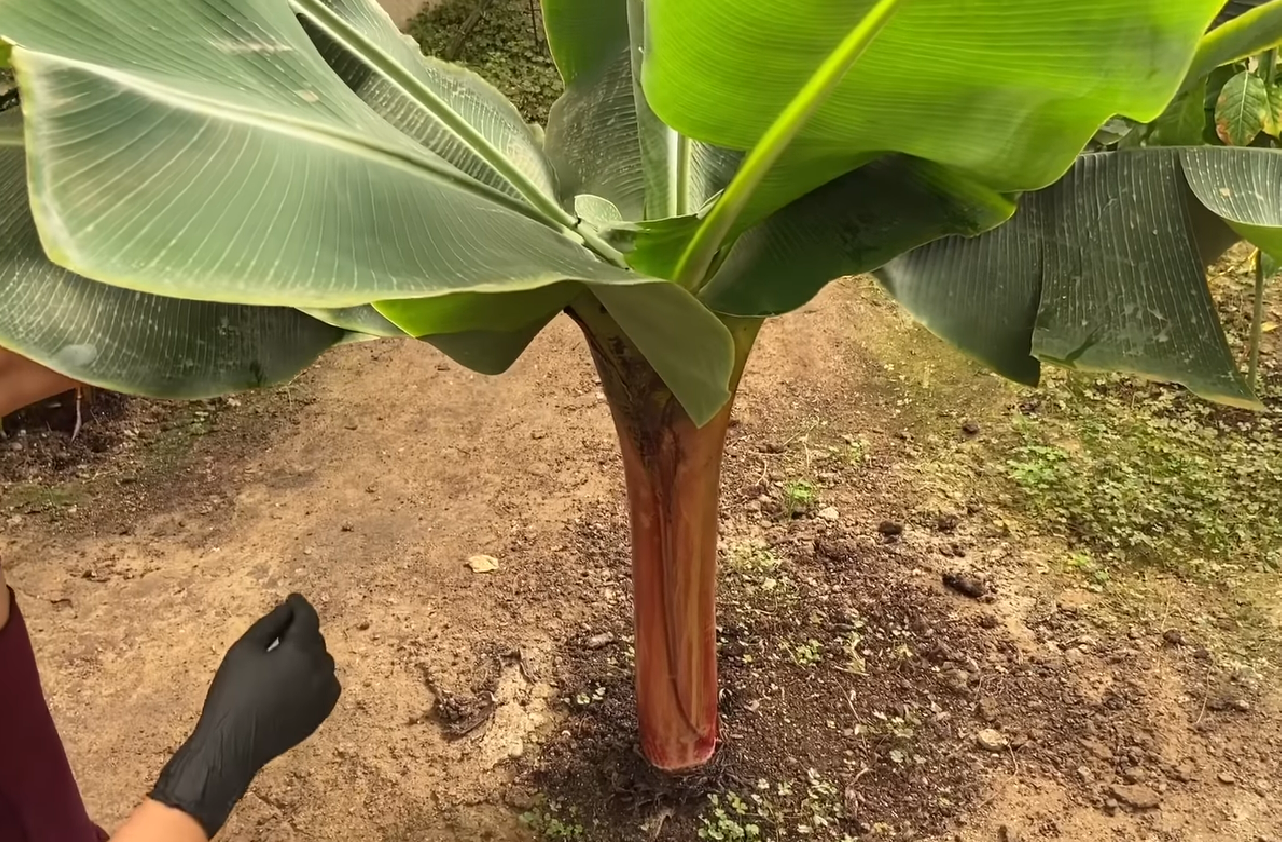
Fertilize your banana tree monthly with a balanced fertilizer formulated for palms and other tropical plants. Follow package directions for how much to use based on the size of your tree.
Water your banana tree deeply and regularly, especially during hot, dry weather. The soil should be moist but not soggy. Mulch around the base of the tree to help retain moisture in the soil.
You may see flowers on your banana tree soon after planting it. These flowers will eventually turn into bananas, but they’re not edible. Once the bananas are mature, cut them off the bunch and enjoy![4]
Can banana plants survive winter in the ground?
If you live in an area where temperatures dip below freezing, it’s best to grow your banana plant in a pot so you can bring it indoors during the cold months. Banana trees are tropical plants and cannot tolerate frost. However, if you do choose to plant your banana tree outdoors, make sure to mulch around the base of the plant to protect the roots from freezing.
In general, banana trees are not too picky about soil as long as it is well-draining. If you live in an area with heavy clay soils, consider planting your banana tree in a raised bed or container to prevent the roots from sitting in waterlogged soil. Amend heavy soils with organic matter such as compost or peat moss to help improve drainage.
Banana trees need full sun to partial shade to thrive. In too much shade, the leaves will become yellow and the plant will produce fewer fruits. If you live in a hot climate, choose a spot that gets morning sun and afternoon shade to protect the plant from the hottest temperatures of the day.[5]
Safety Considerations
One of the most important things to consider when growing a banana tree indoors is safety.
It’s also important to be careful when handling the plant, as the sap can cause skin irritation in some people. If you do get sap on your skin, wash it off immediately with soap and water.[1]
Potential Pests and Diseases
One of the great things about growing banana trees indoors is that they are relatively pest and disease free. However, there are a few pests and diseases to be aware of, including:
- Banana aphids – These small, pear-shaped insects feed on the sap of banana trees and can cause leaves to curl and deform. If you see banana aphids on your indoor banana tree, you can remove them by spraying them with water or rubbing alcohol.
- Fusarium wilt – This fungal disease affects the vascular system of plants, causing them to wilt and die. Fusarium wilt is spread by contaminated soil, so it’s important to sterilize any tools or containers that come into contact with your banana tree.
- Panama disease – This soil-borne disease can be fatal to banana trees, so it’s important to be on the lookout for any symptoms, including yellowing leaves, wilting, and fruit rot. If you think your banana tree has Panama disease, it’s best to remove it from your home and dispose of it properly.[1]
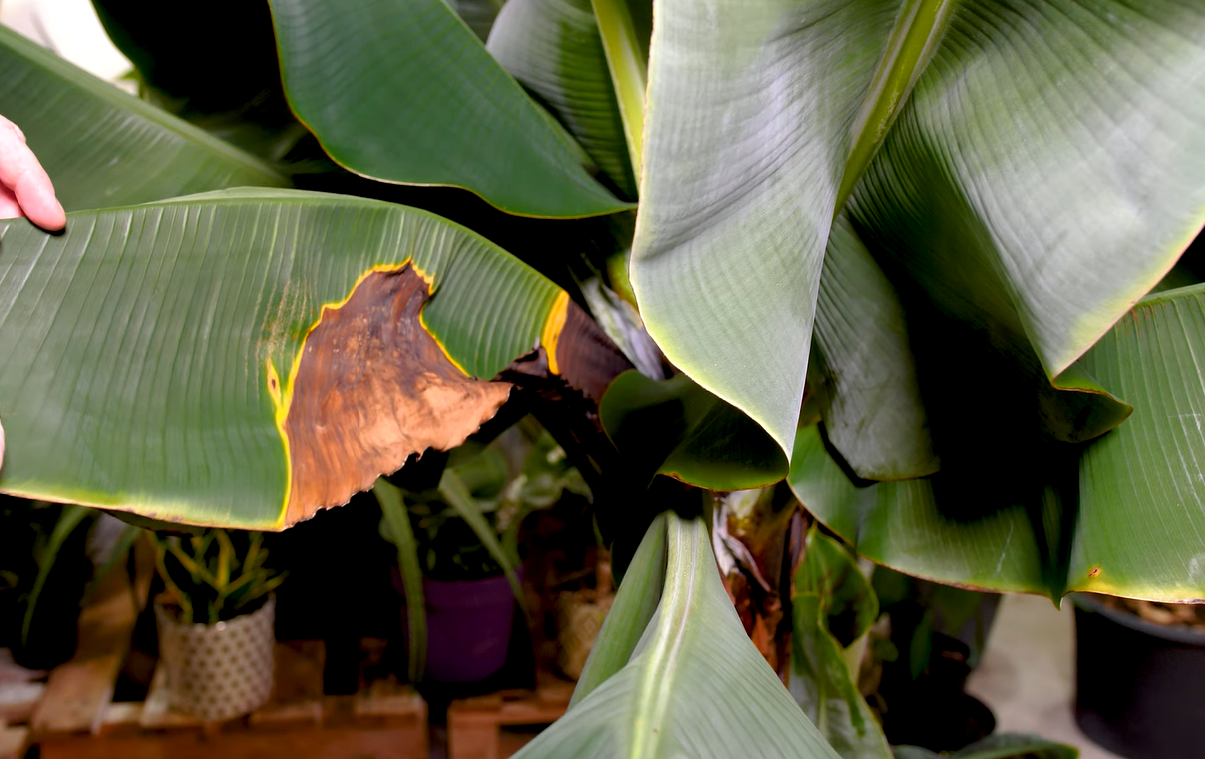
Pruning
Pruning your banana tree is important to encourage new growth and keep the plant healthy. You’ll want to prune away any dead or diseased leaves, as well as any suckers that are growing from the base of the plant. You can also trim back any long or straggly leaves to tidy up the plant’s appearance.
To prune your banana tree, use a sharp pair of shears or pruning saw. Make clean cuts at a 45-degree angle, being careful not to damage the main stem of the plant. After you’ve finished pruning, remove all of the cuttings from around the base of the plant so that they don’t rot and attract pests.[2]
Potting
Banana trees are tropical plants, so they need well-drained, moist soil rich in organic matter. You can use a standard potting mix or make your own by mixing equal parts peat moss, perlite, and vermiculite.
The size of the pot you choose will depend on the size of your banana tree. A small tree will do fine in a 12-inch pot, while a larger tree may need a 20-inch pot. If you’re not sure, it’s better to err on the side of too big rather than too small.[2]
Be sure to choose a pot with drainage holes to prevent the roots from rotting. You can also add a layer of gravel to the bottom of the pot for extra drainage.[5]
Toxicity
Banana trees are not poisonous; however, the leaves and stems contain sap that can cause skin irritation. If you come into contact with this sap, wash the area with soap and water immediately. Also, keep in mind that banana trees are a food source for animals like slugs and snails. So, if you have pets that eat plants, it’s best to keep them away from your banana tree.
While banana trees aren’t poisonous, they can be a choking hazard. The leaves are large and floppy, which means they can easily cover a small child’s face. And the fruit itself is a choking hazard because of its size and shape. So, if you have small children or pets, it’s best to keep them away from your banana tree.[3]
FAQ
Can you grow banana trees from cuttings?
Yes, you can grow banana trees from cuttings. You will need to take a cutting that is at least six inches long and has at least three leaves. Make sure to remove any flowers or fruit from the cutting. You will also need to use a rooting hormone on the cutting before planting it in moist soil.
It is best to plant the cutting in a pot that is at least 12 inches deep. Water the cutting regularly, and it should begin to sprout roots within two weeks. Once it has roots, you can transplant it into a larger pot or outdoors if you live in an area with warm weather year-round.
How do you increase the growth of a banana tree?
There are a few things you can do to encourage faster growth in your banana tree. One is to fertilize regularly with a good quality fertilizer formulated for palms and tropical plants. Also, make sure your tree is getting enough water – but not too much! – as both under and over-watering can stunt growth. And finally, provide some bright indirect sunlight for your tree – too much direct sun can scorch the leaves.
What should I feed my banana plant?
Banana trees are not heavy feeders, but they do appreciate a little extra nutrients during the growing season. A good quality all-purpose fertilizer will work fine, or you can use a fertilizer specifically formulated for bananas. Apply the fertilizer according to the package directions and be sure to water it in well.
How do you fertilize a banana tree naturally?
Banana trees need a lot of fertilizer to produce fruit. The best way to fertilize a banana tree is with organic compost or manure. You can also use chemical fertilizers, but they can harm the environment and are not as effective as organic methods.
To fertilize a banana tree, mix compost or manure into the soil around the base of the plant. Apply fertilizer every two months during the growing season. If you use chemical fertilizers, follow the directions on the package carefully.
Is Epsom salt good for banana trees?
Epsom salt is a good source of magnesium, which is essential for banana trees. It can help prevent yellowing of leaves and fruit drop. You can add Epsom salt to the soil or spray it on the leaves.
How do I get my banana tree to bloom?
If you want your banana tree to bloom, you need to make sure it is getting enough sunlight. Banana trees need at least six hours of direct sunlight each day in order to bloom. If your banana tree is not getting enough sunlight, you can try moving it to a sunnier spot. You can also try using a grow light to supplement the natural sunlight.
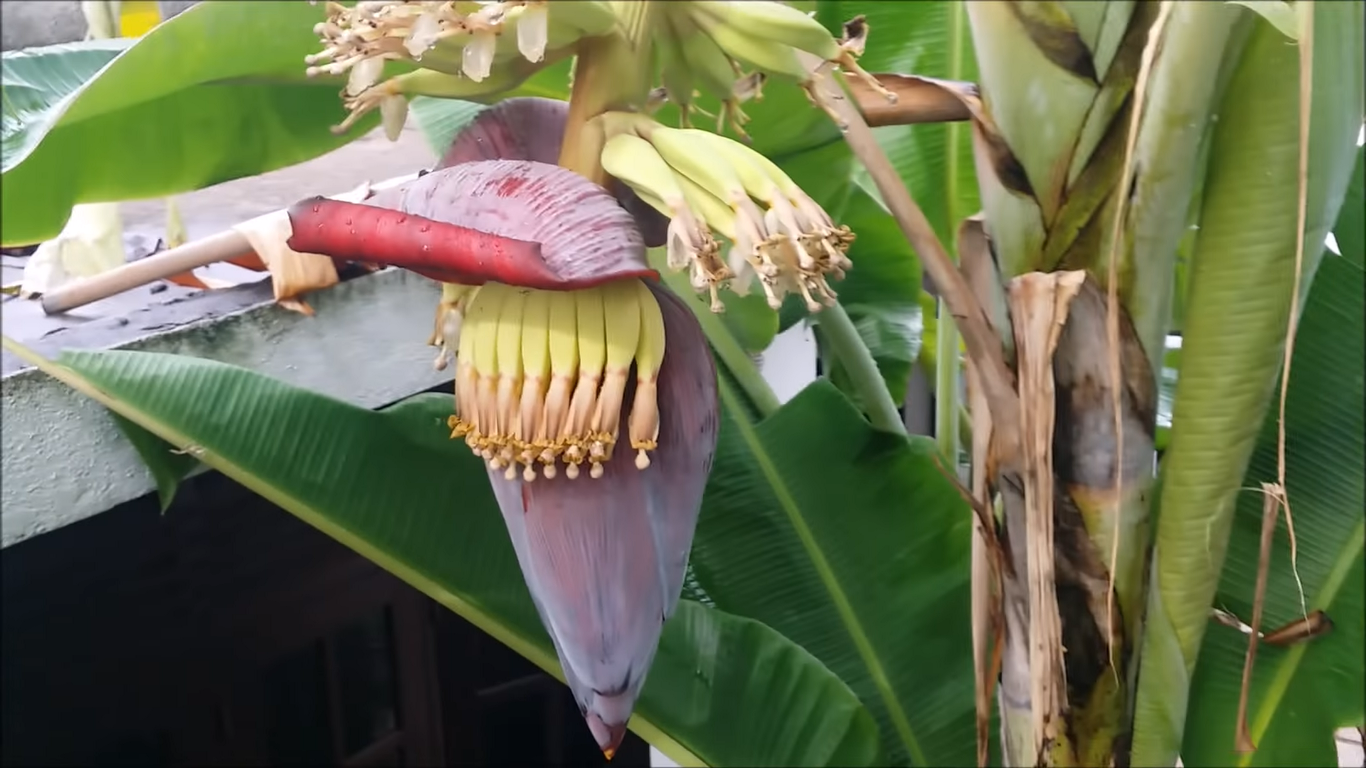
Another thing that you can do to encourage blooming is to fertilize your banana tree regularly with a high-phosphorus fertilizer. Phosphorus is an essential nutrient for plants, and it helps promote blooming.
Finally, if your banana tree still isn’t blooming, it might be because it’s too young. Banana trees typically don’t start blooming until they are three or four years old. So, if your banana tree is still a baby, don’t worry – it will eventually bloom!
Should I trim banana leaves?
Banana trees are fast-growing plants, so they’ll quickly produce new leaves. Trimming also helps keep the plant’s size under control.
If you want to learn more about how to care for your banana tree, check out our comprehensive guide. It covers everything from watering to fertilizing to pruning.
Useful Video: BANANA TREE – HOUSE PLANT CARE GUIDE!
Conclusion
We hope this article has been helpful in answering your questions about banana tree indoor care. Remember to always consult a professional if you have any specific concerns. And be sure to check out our comprehensive guide for more detailed information. Thanks for reading!
References:
- https://www.bobvila.com/articles/how-to-grow-a-banana-plant-indoors/
- https://www.thespruce.com/banana-tree-growing-profile-3269353
- https://www.plantssparkjoy.com/grow-indoor-banana-plant/
- https://www.bybrittanygoldwyn.com/banana-plant-care/
- https://www.studioplant.com/en/blog/propagation/banana-plant



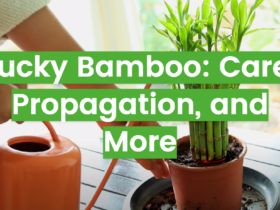
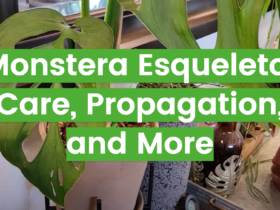

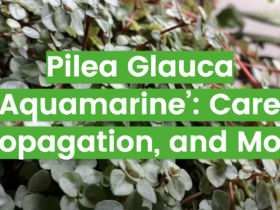
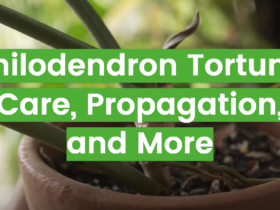
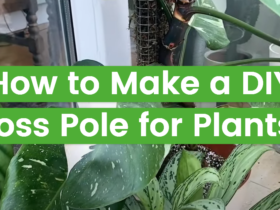
Leave a Review